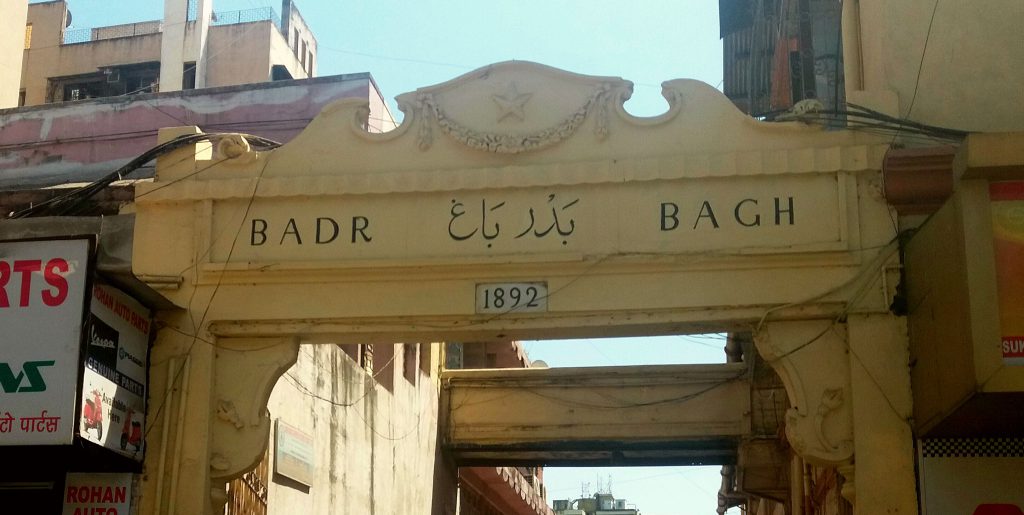Female Genital Mutilation/Cutting: Work of the devil?

By: Koen Van den BrandeAge: 56 Country: India I rarely speak of the devil. In Germany they have a saying: Du sollst den Teufel nicht an die Wand mahlenLiterally this translates to ‘Don’t paint a picture of the devil on the wall’. Loosely translated it means that you should not invite evil by talking about it. But maybe there are times we have a duty to alert others to the devil’s work. What I mean by that is not that anyone in particular is a devil but rather that maybe at times the devil has a hand in misleading people. My efforts to get to the bottom of the origins of the practice of ‘khatna’ – what the rest of the world calls ‘Female Genital Mutilation’ (FGM) – in the Suleimani community, recently led me to the inevitable conclusion that the devil has had a hand in twisting the words of the Prophet PBUH, to mean the opposite of what He was saying. My attention was drawn to some research carried out by learned members of the Muslim community. Let me present the facts to you so that you may come to your own conclusion. Early on in my own research I came across a Hadith – a reported saying of the Prophet – which was being quoted as evidence of tacit approval of this ancient practice, which predated Islam and may have been initiated in the distant past to subdue the sexual urges of female slaves. My discussions with members of the Suleimani community had made it clear that the Daim-ul-Islam is the rulebook to which many show an unquestioning allegiance. Of course such blind faith can have dire consequences. The Daim-ul-Islam does indeed refer to the Hadith in question. Following is an extract from a paper published on www.alislam.org, with the title ‘Female circumcision and its standing in Islamic law’. But it turns out this is not the full Hadith. In full, the Hadith seems to leave little doubt as to where the Prophet stood on this matter. The authors of the report quote from Al-Kafi, a respected Shiite book of traditions. Was the Prophet endorsing, encouraging or even mandating that women should be cut? Or was he signaling his disapproval and in the face of a long-established tradition, trying to limit the harm done to women? Given what he says, is it correct to claim, as some do, that he should have forbidden it, if he really felt it was wrong? I will leave it to you to draw your own conclusion. For me these words of Mohammed, now in full view, are consistent with other issues where he championed the rights of women in the face of a culture which at that time saw no reason to do so. Who decided to shorten the hadith and to what end? And at which point did a woman who ‘used to circumcise women slaves’ become a woman who ‘used to circumcise girls’? There is a substantive difference is there not? Just as with the modern day suggestion that Mohammed condoned wife-beating, when in fact he counseled restraint and suggested several alternative ways of resolving marital disputes or the insistence by some on the validity of ‘triple talaq’ divorce, where in fact careful mediation over a period of time is prescribed, one can only conclude that the devil himself has repeatedly sought to undermine the Prophet’s cause as champion of the rights of women! Today we call this ‘fake news’ and we are learning day by day, how it is used to mislead those who believe without questioning. Witness how the young parents of our community are systematically fed disinformation, building on that same principle of blind faith. But blind faith in whom? I quote from the website www.islamqa.com. Search for the term ‘khatna’ and the following question is addressed, among others: This is how the scene is set: I wonder what a properly qualified medical practitioner would make of some of the advice given. Need I say more ? How do we tackle such blatant attempts at misleading parents of young girls? Surely the best strategy must be to focus on facts and truth. So I am attempting to find a consensus across the Suleimani community around the following statement. “I as a member of the Suleimani Jamaat, in the interest of young parents and their girls, want to reflect what I believe to be the truth about the practice of khatna. Fact is … It is a tradition which predates Islam It is not mentioned in the Quran at all It is not practiced by all muslims It has been declared a crime in several Muslim majority countries It is considered a health hazard by the World Health Organization It is considered a crime against a child by the United Nations Truth is, in my humble opinion, that the Prophet Mohammed PBUH frowned upon this practice and sought to prevent harm from being done to women. I believe that these facts should be endorsed by our leadership and communicated to all of the Jamaat ‘s young parents. The Daim-ul-islam states that ‘khatna’ is not obligatory and that it should not be performed before a girl is 7-years-old. I believe that it would be in line with this rule to recommend to parents that any decision to proceed with this practice should be postponed until the age of consent. And in line with the Prophet’s guidance, at a time when it was a more common practice, I believe that when and if it is performed, it must be done symbolically only and cause no harm.” I hope you can join the effort by endorsing this statement. And if you cannot, I invite you to propose an alternative. At least let’s start by banning the use of http://www.isllamqa.com Let us work together to undo the work of the devil. This blog is the third in a three-part series that describes the practice of FGC within the Suleimani Bohra community.
FGM before the Indian Supreme Court

By: Koen Van den Brande Age: 55Country: India It was to be expected… The Indian Supreme Court has been asked to look at the practice of ‘khatna’ – commonly known as FGM (Female Genital Mutilation) as a result of a Public Interest Litigation filed by Sunita Tiwari, a Delhi based advocate. There was a time, not so long ago, when the Suleimani community was known for people who showed great wisdom and leadership. For example when the educator, jurist and author Asaf Ali Asghar Fyzee advocated “the need to incorporate modern reforms in Islamic law without compromising on the ‘essential spirit of Islam’.” FGM has been in the news of late in India as well as the US, the UK and Australia, as a result of legal action taken against practitioners of ‘khatna’ and discussions on how to make existing legislation more effective. In the Mumbai-based Suleimani community, which I belong to, we have also been having some discussions on how to address this practice, which remains prevalent albeit more and more in what I would call an ‘intellectualised’ form. After all, we are not talking here about primitive tribal communities as in some countries in Africa, where in 10% of the cases, we can talk about ‘mutilation’ in the fullest, most horrific, sense. The community is well accustomed with the Islamic principle that the law of the land is to be respected. In the Prophet’s (PBUH) words ’Love of one’s country is a part of one’s faith” So at one level, the introduction of a new law would be the easiest way to address the issue… Or would it? In the UK such a law has been on the statute books for many years without ever leading to a single case in court and yet it is well-known that the practice continues there for thousands of girls. Or take the case of Egypt, where despite a law which declares the practice a crime, 98% of women continue to be cut. As an Egyptian government official comments in the highly informative as well as emotional documentary The Cutting Tradition, soberly narrated by Meryl Streep, you cannot put the entire population of a country in jail… A study in Senegal concluded that the introduction of specific legislation can be helpful, where it complements other efforts to educate and gain support for abandoning such a practice. However the study also observed that such legislation without the necessary work on the ground can build resistance if it is primarily seen as interference in a religious practice. In India there is no lack of existing legislation under which FGM would be seen as a criminal offence, as Maneka Gandhi, Minister for Women and Child Development recently spelled out in no uncertain terms, in response to a referral by the Supreme Court. In addition, supra-national bodies like the United Nations and the World Health Organisation take a clear stand on the subject. India is a signatory to the UN’s Universal Declaration of Human Rights, but it was not even on the radar of the UN until a group of women submitted a petition to recognise India as one of the countries where FGM is still practiced… In India there is the additional problem that the Muslim minority is always likely to find a new law addressing ‘khatna’, considered by some a ‘religious practice’, an imposition by a Hindu-dominated government – even if the law makes perfect sense. Such resentment could result in the practice being driven underground and once again reverting to the earlier back-alley horrors, which so many women have attested to. In fact, following the successful efforts of Sahiyo and others, a new site has recently been set up protesting ‘interference’, as expected. It would of course be much better if the two sides agreed to sit together to work out a sensible way forward. Sunita Tiwari is quite clear. She wants ‘khatna’ to be made an offence which is ‘cognizable, non-compoundable and non-bailable and offenders to get maximum punishment and penalty’. In reality, and for many Suleimani families today, ‘khatna’ has become what a father of two daughters called ‘a minor procedure’, when I asked him about it. That is to say that the ‘intellectualised’ form of the practice already insists on a medical procedure which simply removes a small bit of skin — the clitoral hood. Such a procedure may be justified and carried out legitimately to assist a grown-up woman. Which still leaves the question how one can justify making that decision for a child. As a result of my initial conversations and a bit of research, I wrote an article a while back in which I advocated a possible approach which would respect the view of those who consider this a spiritual matter and the rest of us. I believe this approach would also address the urgent need for reform and recognise that a large majority of the world has deemed this practice, for some time already, a crime against a girl child. What I proposed was that the community leaders could simply teach and mandate that a woman had to be of the age of consent to allow what should then be a largely symbolic ‘cut’ and that it should always be performed under medical supervision. At least one of the Bohra community’s spiritual leaders seems to have taken a similar view. He was reported in the media recently as saying ‘FGM should be by choice for adults’. Unfortunately this statement has become somewhat ‘politicised’ due to the succession struggle which is currently before the court in Mumbai. This proposed approach would also address another ‘law’. It could help resolve the current dilemma for any medical practitioner who would prefer not to break his or her Hippocratic oath. This oath – ‘do no harm’ – insists that a doctor can only perform a procedure on a patient which is actually in that patient’s interest. It must be difficult for any doctor to argue that ‘khatna’ is
Khatna among Suleimanis, from the perspective of an ‘outsider’

by Koen Van den BrandeAge: 55Country: India More than ten years ago, in a nikah ceremony in Karachi, I became a Muslim when I married a member of the Suleimani community. I was an ‘outsider’, born in Europe and baptised a Christian, but it was clear from the questions I was asked to answer, in order to become a Muslim, that there isn’t such a big difference between the three religions of Abraham. Since that time I have been adopted by the Suleimani community in Mumbai and elsewhere as ‘one of them’ and I have been embraced as a member of the family and a friend. I have naturally taken an interest in the teachings of the Prophet – Peace be upon Him – and I have listened with great concern, when those fundamentally sound teachings have been abused and misrepresented, in the interest of men who seek to dominate others, especially women. Listening to Karen Armstrong and Lesley Hazelton and having read their biographies of the Prophet (PbuH), I have learned to consider the historical context, when trying to understand what the Prophet Mohammed (PbuH) was saying and doing. And I think that what he was saying about women was nothing short of revolutionary, considering that women in those days were in effect ‘chattels’, the property of men. The Prophet (PbuH) himself married a businesswoman and gave women the fundamental rights to inherit property and to seek a divorce. And when it came to beating women – a commonly accepted practice then – he asked men to try and resolve disputes lovingly and to tone it down in order not to hurt their wives. It is with that background that I first saw this ‘Hadith’: “A woman used to perform circumcision in Medina. The Prophet (PbuH) said to her: Do not cut severely as that is better for a woman and more desirable for a husband.” Such recollections of what the Prophet Mohammed (PbuH) is believed to have said, but did not record in the Quran, are often used to resolve disputes. This Hadith may be considered poorly supported by the academics, but it seems to me to be in tune with Prophet Mohammed’s (PbuH) gentle approach to teaching men how to treat women in a different manner to what they had been accustomed to and to progress gradually in the right direction. The tradition of ‘circumcising’ not just boys but also girls, predates Islam and continues to be practiced by adherents to other religions, for example by Christians in Egypt and Ethiopia. Today the world calls this practice FGM, ‘female genital mutilation’. It is – rightly in my view – considered a crime against the human rights of a girl under the laws of many countries. I myself was circumcised as a six-year-old boy and I still remember the pain afterwards when I had to pee… But in my case and to some degree that of all Jewish and Muslim boys, there was at least a medical justification for the procedure. There is no such justification for girls and women. Quite on the contrary. The WHO – World Health Organisation – publishes a long list of potential health issues, associated with FGM. I first became aware that girls were subjected to having their genitals cut – a practice called ‘khatna’ in our community – when my wife told me how she remembered the sharp pain, when an auntie in the community did it to her as a child. I was enraged and worried and immediately took a closer interest in the anatomy of the clitoris, in order to try and understand the implications. It turned out we were fortunate. The damage done was not complete. We figured it out together and have no problems. The answer given most often by women, when asked the reason for this practice, is that it is intended to reduce a woman’s libido and thus make her less likely to be promiscuous. I wholeheartedly recommend a book, which helped me gain a much better informed perspective on the anatomy of the female sexual organs and the very different ways in which women experience the pleasure of lovemaking. The title of the book is ‘She comes first – the thinking man’s guide to pleasuring a woman’ and it was written by Ian Kerner, a licensed psychotherapist and well-known counselor on sexuality. I challenge the Muslim men, who are my family and friends, to become ‘thinking men’ and embrace what this book tries to teach. Since the time I learned that my wife had been cut, I sort of assumed that this, otherwise rather liberal Suleimani community, must have left this practice behind and that younger generations of women were likely no longer affected… But there is a problem of course … You cannot really walk up to a woman and ask outright, can you? It is considered a deeply private matter. So it seems many men in the community are unaware. It was news from Australia that a religious leader of the (Dawoodi) Bohra community had been jailed for FGM, which first made me realise that, if the Bohra community still practiced ‘khatna’, it might be true for the Suleimanis as well. And so I gently broached the subject during a gathering with friends and family. I was astonished to see that at least one male member of the group was putting up a strong defense for this practice, by justifying it as somehow ‘required’ by Islam. I read out to him and the group what Dr Ahmed Talib, the then Dean of the faculty of Sharia – Islamic law – at the renowned Islamic university of Al-Azhar in Egypt, had said in 2005… “All practices of female circumcision and mutilation are crimes and have no relationship with Islam. Whether it involves the removal of the skin or the cutting of the flesh of the female genital organs… it is not an obligation in Islam.” But to no avail. So I decided to
A conversation on Khatna with Suleimani Bohras

Is there only a little piece of flesh between ‘good’ and ‘bad’, asks a Suleimani Bohra

